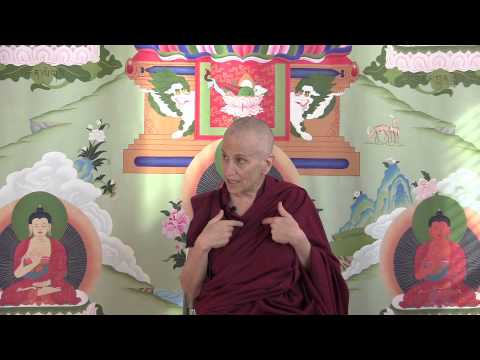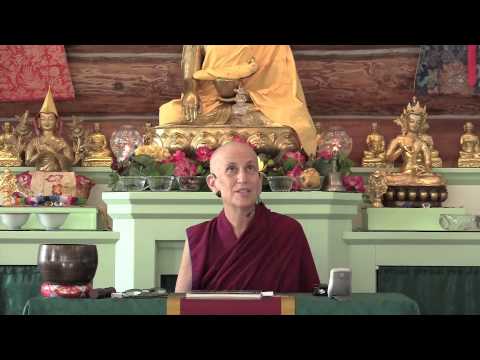Taking down offerings
Setting up your altar, part 3
- Asking permission to take down the offerings
- What to do with food offerings
- How to remove the water bowls
When you take down the offerings at the end of the day, then I think that—my teachers haven’t said this, but I think it’s nice to do—to kind of request the Buddha’s permission to remove the offerings. So, especially if you have food offerings and you’re taking them down, to kind of say, “I’m the caretaker of this shrine and so I’m going to remove those things. Buddha, please may I have your permission to do that?”
And the reason I say that is because I’ve been at places, some temples, where people will come in the morning with a lot of food offerings to make, make a lot of beautiful food offerings on the shrine, and at lunch time when there’s a pot luck lunch, at that time they decide to take the offerings down. And everybody eats them. So it makes me wonder how much were the offerings offered in the first place, and is it just, “Oh, now it’s time for us to eat and we want to eat them,” and then just taking them from the altar … is that not really appreciating that they belong to the Buddha? And just having covetousness ourselves for things that belong to the Buddha. Which is not good. So that’s why I think it’s good, in our mind, to just kind of ask the Buddha’s permission. Or be aware that we’re the caretaker of the shrine and we’re taking things down for that purpose.
When you take down the shrine—I usually have another little table here [in front] that I put things on. But you start at the right end—the opposite end from where you started to fill it—and you empty the water. And then, it depends. If your bowls don’t stain you can just put your bowls upside down and let them drip dry. Or, what you can do is, you again wipe them. And when you’re pouring the water out, and when you’re wiping them, then you say the Vajrasattva mantra as purification:
om vajrasattva samaya manu palaya/ vajrasattva deno patita/ dido may bhawa/ suto kayo may bhawa/ supo kayo may bhawa/ anu rakto may bhawa/ sarwa siddhi mempar yatsa/ sarwa karma su tsa may/ tsitam shriyam kuru hum/ ha ha ha ha ho/ bhagawan/ sarwa tatagata/ vajra ma may mu tsa/ vajra bhawa maha samaya sattva/ ah hum pey
Like I said, normally I have a little table that’s next to this. So I’m reaching quite far.
And you can put your bowls upside-down [in a row]. Or you can also stack them. However you want to do it.
When you empty the water and when you wipe the bowls, again you’re thinking the wisdom realizing emptiness is purifying the defilements of sentient beings. And it’s really important, both when you’re making the offerings and when you’re taking them down, to try and be as neat and tidy as you can be, and not spill water all over the place. So it’s quite a mindfulness practice.
And then the water that you’ve taken out, you take outside. You don’t put it down your drain or down your toilet. If you have house plants you can put it on your house plants. You can take it outside and put it where nobody walks. And the food that you take down, it should always be taken down before it gets kind of moldy and old and everything. And actually, when you offer things, you should offer the best quality to the Buddha. So if you go shopping, don’t look through the apples and, “Oh, these ones got bruised so I’ll offer those and these ones are nice, I’ll keep them for myself.” It should be the opposite. Okay?
But then when you take the food down, then you can either give it to others, or you and your companions can eat it.
Audience: So when you leave the bowls like that overnight, then you take the one on the left …
Venerable Thubten Chodron (VTC): Oh, if you leave them there overnight, it doesn’t matter which order you start to clean them in. Is that what you were going to ask?
Audience: Well, I for years have been trying to make sure that each day the same bowl in the same place.
VTC: Oh, I don’t know if that matters. If it does, I haven’t heard it.
But you can start on either end. So the next day if you come, then you would again make your bows, generate your motivation, and then you can start on whatever side and again cleanse them and stack them. And then you would offer them again.
Audience: [inaudible]
VTC:They usually say to have seven bowls. How many sets of seven? Just as many as you want to offer. And if you don’t have seven, you can offer one, two, five … I don’t know why the number seven. Somebody likes it. But if you don’t have that many, you can offer more, you can offer less. As many as you want to offer, then that much more merit you create.
And then there’s another way to make offerings that is more in conjunction with tantric practice, and that’s when you make the eight offerings: water to drink, water to wash the feet, flowers, incense, light, perfume, food, and then usually if you’re doing a tantric ritual you have a bell and sometimes a drum, and that would be the music one. But that’s a different way to make offerings. And sometimes you set it going from left to right, sometimes you set it going from right to left. But that’s another topic.
Part 1 of this series:
Part 2 of this series:
Venerable Thubten Chodron
Venerable Chodron emphasizes the practical application of Buddha’s teachings in our daily lives and is especially skilled at explaining them in ways easily understood and practiced by Westerners. She is well known for her warm, humorous, and lucid teachings. She was ordained as a Buddhist nun in 1977 by Kyabje Ling Rinpoche in Dharamsala, India, and in 1986 she received bhikshuni (full) ordination in Taiwan. Read her full bio.


